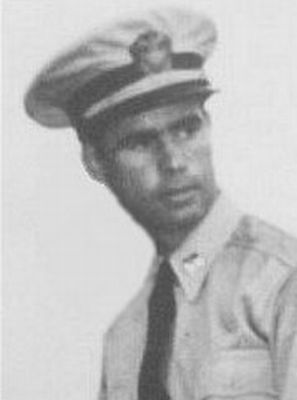Paine, Roger Warde Jr.
- Date of birth:
- August 13th, 1917 (Austin/Texas, United States)
- Nationality:
- American
Biography
Roger Warde Paine, Jr. was born on 13th August 1917 in Austin, Texas. He was the son of Rear Admiral Roger W. Paine and Mrs. Corine (Malone) Paine. After his education at the Western High School, Washington D.C. ans Coronado High School, California, he entered the U.S. Naval Acedemy in 1935. He graduated and was commissioned to Ensign on 1st June 1939. His first assignment was on the battleship U.S.S. Arizona. In December 1940 he was detached for submarine trainingat the Submarine Base, New London, Connecticut. He joined the cres on board of the U.S.S. Pompano in April 1941.
When war broke out on 7th December 1941 he still served on the ship and sailed for his forst warpatrol. Between March 1942 and August 1943 he served on the U.S.S. Wahoo and became its Executive Officer and Navigator. Just before its fifth patrol he went into hospital for appendicitis. For his duty on the Wahoo he was entitled to wear the Presidential Unit Citation. Then Lieutenant Paine, was given command of the U.S.S. S-34 for a brief moment and in August 1944 became the Executive Officer and Navigator on the U.S.S. Tinosa. In May 1945 he was ordered to report on the U.S.S. Cubera at the Electric Boat Company in Groton, Connecticut and became its commander on the ships commissioning at 12th December 1945.
After shis first postwar assignment, het briefly commanded the U.S.S. Whale until its decommissioning on 1st June 1946. Until 1951 he studied Ordinance Engineering (Special Physics Course) at the Postgraduate School, Annapolis, Maryland, at the Massachusetts Institute of Technology at Cambridge where he received the degree of Master of Science in Nuclear Physics. and worked at the Los Alamos (New Mexico) Scientific Laboratory. Between August 1951 and September 1953 he commanded the U.S.S. Cowell and reported in September 1953 as Chief of the Analysis Branch, Armed Forces Special Weapons Project, Washington, D.C. Between August 1956 and June 1957 he studied at the Naval War College, Newport, Rhode Island and after that became Commander, Destroyer Division 282 in July.
From November 1958 he headed the Guided Missile Branch, Research Division at the Bureau of Ordinance, Navy Department, Washington, D.C. In 1959 he became Director of the Missile Guidance and Airframe. In September 1961 he went back to an operational command as commander of the U.S.S. Topeka and returned to Washington, D.C. in November 1962 as Head of the Surface Warfare Branch, Office of the Chief of Naval Operations, Navy Department. In June 1963 he reported as Military Assistant to the Deputy Director of Defense Research and Engineering (Administration and Management), Office of the Secretary of Defense, Washington, D.C. End 1966 he was promoted to Rear Admiral and became Commander, Cruiser-Destroyer Flotilla 10 in December. In the Spring of 1967 changed his area of operations to the Mediterranean as Commander of an Attack Carrier Strike Group and in January 1968 became Director of the Navy Information Systems Division, Office of the Chief of Naval Operations. In August 1970 he detached for duty as Commander, Training Command, U.S. Pacific Fleet with Fleet Training Activities in Japan, Guam, Hawaii, San Diego, Long Beach and San Francisco and retired from naval service in the summer of 1972.
Do you have more information about this person? Inform us!
- Period:
- Second World War (1939-1945)
- Unit:
- USS Pompano
- Awarded on:
- 1942
Awarded the Navy Commendation Medal with Combat "V".
- Period:
- Second World War (1939-1945)
- Rank:
- Lieutenant (j.g.)
- Unit:
- USS Wahoo (SS-238)
- Period:
- Second World War (1939-1945)
- Rank:
- Lieutenant
Awarded as Golden Star in lieu for the Second Bronze Star to go on the ribbon of the first BS, also awarded with the "V" for Valour.
Sources
- Photo 1: Paul Crozier
- Photo: US Navy Photo through Paul Crozier
- - Legends of the Deep





